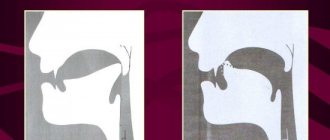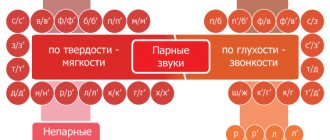Plan of individual correctional and developmental classes for a teacher-defectologist
Logical connections and relationships:
installs with errors (it is difficult to find an extra item).
Mathematical representations
Check:
within 5, sums up after the prompt, does not count backwards.
Correlation between number and quantity:
correlates within 5.
Correlation of figure, number and quantity:
correlates within 5.
Computing skills:
with mistakes.
Calculates:
based on a specific material.
Performs tasks:
both independently and with the help of an adult.
Solving arithmetic problems:
solves within 3.
Learning ability
Help:
needs stimulating help when having difficulty completing a task.
Nature of assistance:
Stimulating and guiding assistance and step-by-step adult supervision are required.
Scope of assistance:
average
Transferability to similar assignments:
the transfer is carried out, but additional time is required to assimilate and consolidate the demonstrated method of action.
Defectological conclusion:
Specific difficulties in developing study skills.
The level of learning is average.
Cognitive activity is at an average level.
Planned events:
Classes with a speech pathologist teacher individually and in a subgroup with a frequency of three lessons on the formation of elementary mathematical concepts and two on familiarization with the outside world per week.
The content of the work .
I
(October 2021 – December 2020)
1. Familiarization with the outside world
- continue to introduce objects of the immediate environment: toys, clothes, shoes, etc.;
- learn to correctly use sensory standards in speech, compare familiar objects;
- consolidate ideas about oneself, one’s family, family members, learn to determine the degree of kinship.
- continue to introduce the kindergarten, the work of adults, its contents: teacher, salesperson, cook, nurse, etc.;
-expand ideas about holidays: New Year, winter entertainment.
- expand ideas about the seasons and natural phenomena;
- introduce the names of the parts of the day;
- learn to determine the state of the weather, changes in nature, describe them, establish the simplest connections between natural phenomena;
-expand ideas about the plant world: vegetables, fruits, trees, mushrooms, berries;
-continue to introduce the animal world: wild animals, their young, domestic animals, their young, poultry, note their characteristic features, expand ideas about the characteristics of behavior, movement, and the benefits they bring to people;
— introduce people to the work of caring for pets;
- learn to differentiate general concepts.
- learn to compose a story of 3-4 sentences about the subject, the content of the plot picture according to the reference diagram.
Long-term plan for individual speech therapy work
Long-term plan for individual speech therapy work from _____________________________________________ for the 20____-20____ academic year.
Goals and objectives
Main directions of correctional work
Careful and comprehensive preparation of the child for correctional work.
1. Arouse interest in speech therapy classes, even the need for them.
2. Development of auditory attention, memory, phonemic perception in games and special exercises.
3. Formation and development of articulatory motor skills to the level of minimal sufficiency for producing sounds.
4. In the process of systematic training, mastery of the finger gymnastics complex.
5. Strengthening physical health (consultations with specialist doctors, drug treatment if necessary).
Formation and development of articulatory motor skills, speech breathing, voice.
1. Muscle massage:
- Chest, neck and arms;
- Faces;
- Lip;
- Language.
2.Development of speech breathing.
3. Development of the voice and melodic-prosodic side of speech.
4. Development of kinetic and kinesthetic sensations from articulatory patterns.
5.Articulation gymnastics.
Development of phonemic hearing.
1. Development of auditory perception, attention, memory.
- Exercises to differentiate sounds that differ in tonality, pitch, and duration.
- Reproducing a rhythmic pattern by ear.
2. Development of phonemic perception.
- Exercises in recognizing a given sound among other phonemes and isolating it from a word in various positions.
- Exercises to differentiate sounds that are similar in articulatory or acoustic properties.
3.Formation of sound-letter and syllabic analysis and word synthesis.
4. Consistent calculation and combination of sounds in words of different syllabic structures.
- Designation of vowels and consonants (hard and soft) sounds with chips of the corresponding colors.
- Drawing up conditional graphic diagrams.
Elimination of sound pronunciation defects
1. Setting sounds:
sibilants S, 3, C, S', 3′;
hissing Ш, Ж; hissing Ch, Sh;
sonors R, R', L, L'.
Preparatory exercises (except articulation gymnastics):
for whistling: “Smile”, “Fence”, “Shovel”, “Groove”, “Brush”, “Football”, “Focus”;
for sizzling ones: “Tube”, “Delicious jam”, “Cup”, “Mushroom”, “Let’s warm our hands”;
for R, R': “Chatterer”, “Painter”, “Turkey”, “Horse”, “Mushroom”, “Drummer”, “Accordion”, “Machine Gun”; for L: “Smile”, “Shovel”, “Let’s punish the tongue”.
2. Automation of each corrected sound in syllables as they are produced:
a) С, 3, Ш, Ж, С', 3′, Л' are automated first in direct syllables, then in reverse syllables, and lastly - in syllables with a combination of consonants;
b) Ts, Ch, Shch, L - vice versa: first in reverse syllables, then in forward syllables and with a combination of consonants;
c) P, P' can begin to be automated from the prototype analogue and at the same time generate vibration.
3. Automation of sounds in words is carried out following the traces of automation in syllables.
As the pronunciation of each syllable is mastered, it is immediately introduced and fixed in words with that syllable.
4. Automation of sounds in sentences.
Each word practiced in pronunciation is immediately included in separate sentences, then in short stories, nursery rhymes, simple sayings, and poems with this word are selected.
5. Differentiation of sounds:
S-3, S-S', S-C, S-Sh; F 3, F Sh; Ch-S', Ch-T', Ch-Shch;
Shch-S', Shch-T', Shch-Ch, Shch-Sh; R-L, R-R', R'-L', R'-Y, L'-L;
6. Automation of sounds in spontaneous speech (in dialogic speech, in games, entertainment, routine moments, excursions, work...).
Overcoming violations of the syllabic structure of words.
- Formation of spatiotemporal representations and optical-spatial orientation.
- Formation of the concept of sound-syllable sequence.
- Formation of the concept of the sequence of sound filling of words of simple and complex syllabic structure.
5. Development of comparative analysis skills: comparing words in which consonants and vowels are in different positions.
Development of fine motor skills of the hands and improvement of graphic and calligraphic skills.
- Development of fine motor skills of the hand and fingers:
- Finger gymnastics;
Exercises to develop free hand movements
- Various types of work with scissors, plasticine, paper;
- Working with the designer;
- Working with patterns and stencils.
Hatching in various directions, coloring.
- Development of visual-motor trajectories:
- work on visual-motor trajectories;
- graphic dictations;
- exercises designed for visual-motor memorization;
- drawing by dots, dotted lines;
- drawing ornaments.
- Development of auditory-motor coordination:
- auditory dictations;
- encrypted dictations;
- work according to verbal instructions.
Development of visual perception.
- Formation of the integrity of visual perception:
- working with silhouette, contour, noisy, superimposed images of objects, letters and numbers;
- recognition of familiar objects, images of letters and numbers from an unusual angle;
- restoration from incomplete images of the whole, completing drawings and coloring according to the model;
- constructing figures, letters and numbers from sticks and individual elements.
- Developing the ability to concentrate and distribute attention.
- Labyrinths.
- Drawing ornaments.
- Visual and encrypted dictations.
Work on enriching, clarifying and systematizing the dictionary.
- Clarification of the meanings of existing words.
- The accumulation of ideas and knowledge about objects and phenomena in the immediate environment.
- Expanding the verb dictionary.
- Expanding the feature dictionary:
- Adjectives;
- Antonimov;
- Synonyms.
- Expansion of the dictionary of adverbs.
- Expanding the dictionary of numerals.
- Expanding the vocabulary of pronouns and auxiliary parts of speech: prepositions, conjunctions, particles.
- Clarification of the lexical meaning of various prepositions.
- Enrichment of the dictionary on lexical topics.
- Learning generalization and classification.
- Learning to select related words.
Development of grammatical structure of speech.
1. Teaching the prefix method of word formation.
2. Teaching the suffixal method of word formation.
- Coordination exercise:
- noun and adjective;
- noun and verb.
- Formation of the genitive plural of a noun.
- Formation of relative and possessive adjectives.
- Clarification of the meaning of the syntactic constructions used.
Development of coherent speech.
- Development of skills in constructing a coherent statement.
- Programming the meaning and semantic culture of the statement.
- Establishing logic (connectivity, consistency).
- Precise and clear formulation of thoughts in the process of preparing a coherent statement.
- Selection of linguistic means adequate to the semantic concept for constructing a statement for certain purposes of communication (proof, reasoning, conveying the content of the text, plot picture).
- Mastery of complex syntactic structures that reflect cause-and-effect and spatial-temporal relationships.
Activation of vocabulary, filling gaps in the field of lexico-grammatical structure of speech.
- Clarify the meanings of the words the students have.
- Continue enriching your vocabulary by accumulating new words related to different parts of speech.
- Clarify (consolidate) knowledge about the composition of a word. Develop the ability to select related words.
- Clarify the meanings of the prefixes. Develop (consolidate) the ability to form new words using prefixes.
- Clarify the meanings of suffixes. Develop (consolidate) the ability to form new words using suffixes.
- Clarify the lexical meaning of words formed using various groups of suffixes.
- Generalize (consolidate) knowledge about the morphological composition of a word.
- To develop the skill of using various methods of word formation.
- Clarify the lexical meanings of various prepositions.
- Form (consolidate) the ability to coordinate words in phrases, sentences, models of various syntactic constructions.
- Develop skills: programming the meaning and semantic structure of statements; establishing the logic (coherence, consistency) of presentation.
- Select linguistic means that are adequate to the semantic concept for constructing a statement for certain purposes of communication (transmitting the content of the text, plot picture, reasoning, proof)
Work to prevent and overcome dyslexia.
- Differentiation of sounds mixed (or defectively pronounced) in one’s own speech.
- Sound differentiation:
- by hardness - softness;
- by voicedness - deafness;
- whistling - hissing.
- Improving sound-letter and syllabic analysis and synthesis.
- Improving the grammatical structure of speech.
- An exercise in distinguishing optically similar letters.
Work to prevent and overcome dysgraphia.
- Differentiation of sounds mixed (or defectively pronounced) in one’s own speech.
- Sound differentiation:
- by hardness - softness;
- by voicedness - deafness;
- whistling - hissing.
- Improving sound-letter and syllabic analysis and synthesis.
- Development of comparative analysis skills: comparing words in which consonants and vowels are in different positions.
- Consolidating knowledge of indicating the softness of consonants with vowels in writing.
- Improving the grammatical structure of speech.
- Exercises designed for visual-motor memorization, prevention of kinetic dysgraphia.
- Work to overcome agrammatic dysgraphia.
- An exercise in distinguishing optically similar letters.
- Work to overcome optical dysgraphia.
- Improving the grammatical structure of speech.
Work to prevent and overcome dysgraphia.
- Development of speech analysis and synthesis at the level of text, sentence, word.
- Development of phonemic perception, ideas, differentiation.
- Development of phonemic representations, sound-letter analysis and word synthesis.
- Development of phonemic differentiation based on the material of hard and soft consonants.
- Development of visual differentiation based on letters. (First, work on phonemic differentiation of sounds).
- Development of phonemic differentiation based on the material of voiced and voiceless consonants.
- Development of phonemic differentiation in the group:
- whistling - hissing;
- affricates and sounds included in their composition.
Development and improvement of psychological prerequisites for learning:
- stability of attention;
- observation (especially to linguistic phenomena);
- memory abilities;
- switching abilities;
- self-control skills and techniques;
- cognitive activity;
- arbitrariness of communication and behavior.
Formation of full-fledged educational skills:
- planning upcoming activities: (acceptance of the educational task; active comprehension of the material; highlighting the main, essential in the educational material; determining ways and means of achieving the educational goal);
- control over the progress of one’s activities (from the ability to work with samples to the ability to use special self-control techniques);
- work at a certain pace (the ability to write, count quickly and efficiently; carry out analysis, comparison, comparison, etc.);
- application of knowledge in new situations;
- analysis, assessment of the productivity of one’s own activities.
Development and improvement of communicative readiness for learning:
- the ability to listen carefully and hear the speech therapist teacher without switching to extraneous influences; subordinate your actions to his instructions (i.e. take the position of a student);
- the ability to understand and accept a learning task posed in verbal form;
- the ability to be fluent in verbal communication in order to clearly perceive, retain and concentrate on completing a learning task in accordance with the instructions received;
- the ability to purposefully and consistently (in accordance with the task, instructions) perform educational actions and adequately respond to the control and assessments of the speech therapist.
Formation of communication skills that are adequate to the situation of educational activities:
- answering questions in strict accordance with instructions and assignments;
- answering questions during academic work with adequate use of learned terminology;
- answers in two or three phrases in the course and results of educational work (the beginning of the formation of a coherent statement);
- application of instructions (scheme) when preparing a detailed statement on the course and results of educational work;
- the use of acquired educational terminology in coherent statements;
- contacting a speech therapist or group mate for clarification;
- explanation of instructions, learning tasks using new terminology;
- a detailed report on the sequence of academic work, summing up the lesson;
- formulating tasks when performing collective types of educational work;
- conducting a differentiated survey and evaluating the answers of your comrades (in the role of leader of various types of educational work);
- compliance with speech etiquette when communicating (appeal, request, dialogue: “Please tell me,” “Thank you,” “Be kind,” etc.);
- composing oral coherent statements with elements of creativity (fantasy).
Prevention and overcoming difficulties in mastering the general education program.





